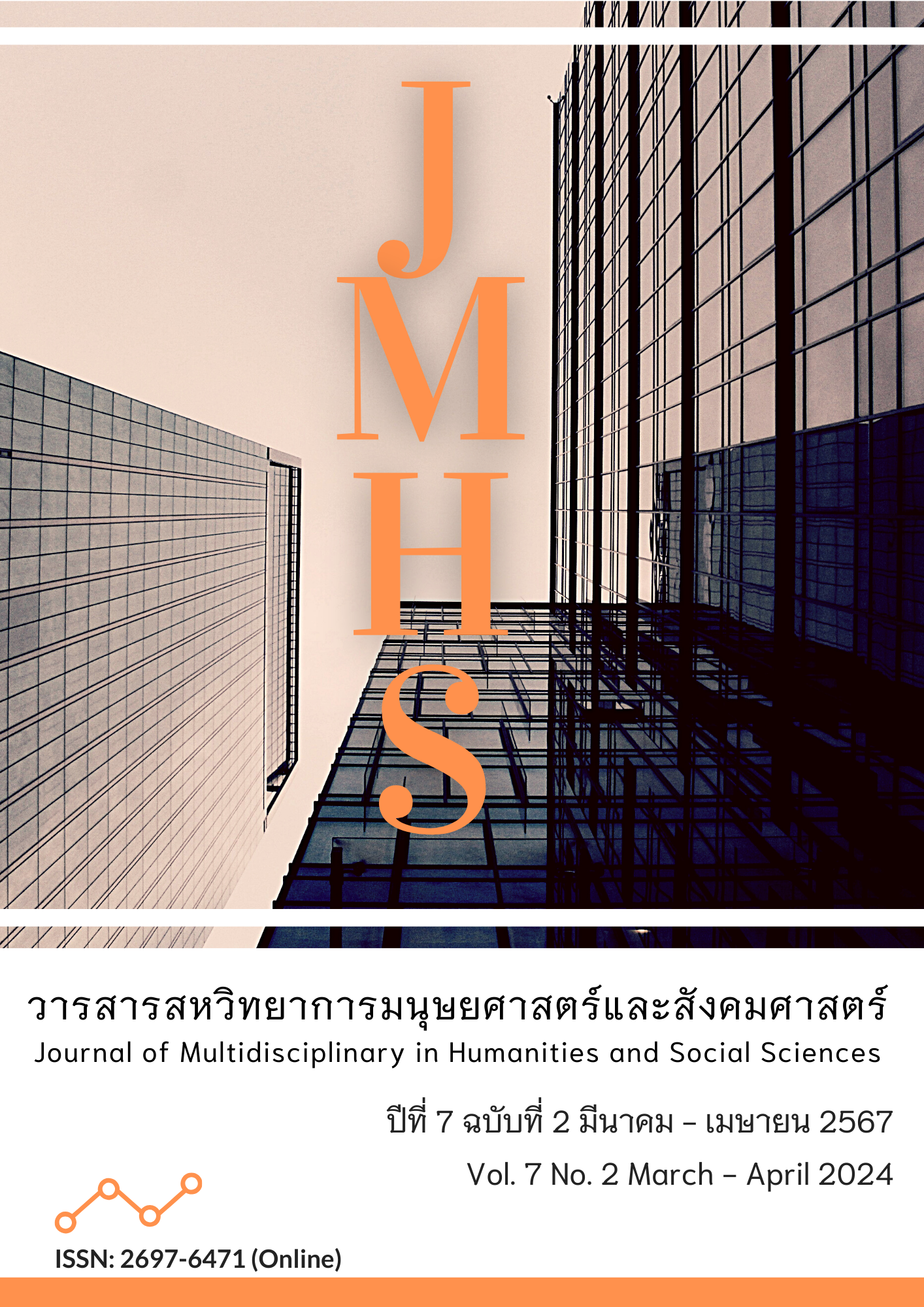Charismatic Leadership Model According to The Principles of Bala for School Administrators Under Bangkok Metropolitan Administration
Main Article Content
Abstract
This article aimed to 1) study the needs and necessities for charismatic leadership among educational institution administrators; 2) develop a charismatic leadership model based on the principles of physical education for educational institution administrators; and 3) evaluate the charismatic leadership model based on the principles of physical education for educational institution administrators Under the Bangkok Metropolitan Administration. This study was mixed methods research.
The results of the study were as follows: 1. The need for the prestige and leadership of school administrators In Bangkok, the highest demand index was for inspiration, followed by intelligence. Practice and create a vision, respectively. 2. The development of a form of prestige leadership in accordance with the principles of physical education for school administrators. Bangkok consists of five components, namely: 1) integrated Buddhism. The development of prestige leadership by integrating with the principles; 2) objectives for the school administrators to have characteristics of prestige leadership; 3) integration of conditions; 4) The use of four school administrations is academic administration. Budget management Personnel management, general administration; and 5) assessment. and 3. Evaluation of the charismatic leadership style based on the principles of physical education for educational institution administrators. Under Bangkok Overall, it is at the highest level. When considering each aspect, it was found that the evaluation results were at the highest level in all 4 areas, namely correctness, usefulness, appropriateness, and feasibility.
Article Details

This work is licensed under a Creative Commons Attribution-NonCommercial-NoDerivatives 4.0 International License.
Views and opinions appearing in the Journal it is the responsibility of the author of the article, and does not constitute the view and responsibility of the editorial team.
References
กัลยาวรรธน์ ตะเภาทอง, สถิรพร เชาวน์ชัย และ วิทยา จันทร์ศิลา. (2565). แนวทางการพัฒนาภาวะผู้นำเชิงเทคโนโลยีของผู้บริหารโรงเรียนขยายโอกาส สังกัดสำนักงานเขตพื้นที่การศึกษาประถมศึกษาพิจิตร เขต 1. Journal of Modern Leaming Development, 7(2), 41-55. สืบค้นจาก https://so06.tci-thaijo.org/index.php/jomld/article/view/253667
ธราธร ตันวิพงษ์ตระกูล. (2562). รูปแบบภาวะผู้นำของผู้บริหารสถานศึกษาเพื่อส่งเสริมความเป็นโรงเรียนแห่งการเรียนรู้ สังกัดสำนักงานคณะกรรมการการศึกษาขั้นพื้นฐาน เขตภาคเหนือตอนบน. วารสารสหวิทยาการวิจัย: ฉบับบัณฑิตศึกษา, 8(พิเศษ), 155-165. สืบค้นจาก https://so03.tci-thaijo.org/index.php/JIRGS/article/view/243635
เนตร์พัณณา ยาวิราช. (2552). ภาวะผู้นำและผู้นำเชิงกลยุทธ์. (พิมพ์ครั้งที่ 7). กรุงเทพฯ: ทริปเพิ้ล เอ็ดดูเคชั่น.
พระพรหมคุณาภรณ์ (ป. อ. ปยุตฺโต). (2550). พจนานุกรมพุทธศาสตร์ ฉบับประมวลธรรม. (พิมพ์ครั้งที่ 15). กรุงเทพฯ: จันทร์เพ็ญ.
มยุรี ศรีวงษ์ชัย และ อำนวย ทองโปร่ง. (2566). ภาวะผู้นำเชิงอำนาจบารมีของผู้บริหารสถานศึกษาในโรงเรียนกลุ่มกรุงเทพตะวันออก สังกัดกรุงเทพมหานคร. วารสาร มจร อุบลปริทรรศน์, 8(1), 463-474. สืบค้นจาก https://so06.tci-thaijo.org/index.php/mcjou/article/view/264228
มหาจุฬาลงกรณราชวิทยาลัย. (2539). พระไตรปิฎกภาษาไทย ฉบับมหาจุฬาลงกรณราชวิทยาลัย. กรุงเทพฯ: โรงพิมพ์มหาจุฬาลงกรณราชวิทยาลัย.
สำนักการศึกษา กรุงเทพมหานคร. (2565). รายงานสถิติการศึกษา ปีการศึกษา 2565 โรงเรียนสังกัดกรุงเทพมหานคร. กรุงเทพฯ: สำนักการศึกษา กรุงเทพมหานคร.
สำนักงานเลขาธิการสภาการศึกษา. (2560). แผนการศึกษาแห่งชาติ พ.ศ. 2560-2579. กรุงเทพฯ: พริกหวานกราฟฟิค.
สำนักยุทธศาสตร์การศึกษา กรุงเทพมหานคร. (2551). ผลการวิจัยที่เกี่ยวข้องกับการจัดการศึกษาของกรุงเทพมหานคร. กรุงเทพฯ: โรงพิมพ์ชุมนุมสหกรณ์การเกษตรแห่งประเทศไทย.
สำนักยุทธศาสตร์และประเมินผล กรุงเทพมหานคร. (2564). แผนพัฒนากรุงเทพมหานคร 2556–2575 : บทสรุปสำหรับผู้บริหาร. สมุทรสาคร: พิมพ์ดี.
สำนักเลขาธิการคณะรัฐมนตรี. (2562). คำแถลงนโยบายของคณะรัฐมนตรี. กรุงเทพฯ: คณะรัฐมนตรีและราชกิจจานุเบกษา.
สุนันทา สมใจ และ วิชุดา กิจธรธรรม. (2561). การบริหารสถานศึกษาด้วยภาวะผู้นำทางเทคโนโลยี. วารสารวิทยาลัยดุสิตธานี, 12(1), 350-362. สืบค้นจาก https://so01.tci-thaijo.org/index.php/journaldtc/article/view/118328
สุพิศ ศรีบัว, จุฬาพรรณภรณ์ ธนะแพทย์ และ สุนทร สายคำ. (2566). การพัฒนาโมเดลภาวะผู้นำการเปลี่ยนแปลงเชิงพุทธสำหรับผู้บริหารโรงเรียนเอกชน. วารสาร มจร อุบลปริทรรศน์, 8(2), 1729-1736. สืบค้นจาก https://so06.tci-thaijo.org/index.php/mcjou/article/view/269241
สุวิมล ติรกานันท์. (2550). การสร้างเครื่องมือวัดตัวแปรในการวิจัยทางสังคมศาสตร์ : แนวทางสู่การปฏิบัติ. กรุงเทพฯ: โรงพิมพ์จุฬาลงกรณ์มหาวิทยาลัย.
สุวิมล ว่องวาณิช. (2558). การวิจัยประเมินความต้องการจำเป็น. (พิมพ์ครั้งที่ 3). จุฬาลงกรณ์มหาวิทยาลัย.
Bass, B. M. (1985). Leadership, and Performance Beyond Expectations. New York: The Free Press.
Baum, J. R., & Locke, E. A. (2004). The Relationship of Entrepreneurial Traits, Skill, and Motivation to Subsequent Venture Growth. Journal of Applied Psychology, 89(4), 587–598. https://doi.org/10.1037/0021-9010.89.4.587
Best, W. J. (1997). Research in Education. (3rd ed.). New Jersey: Prentice Hall.
Conger, J. A., & Kanungo, R. N. (1998). Charismatic Leadership in Organizations. California: Sage.
Damnoen, P. S., Siri, P., Supattho, P. S., & Kaewwilai, K. (2021). The Development of Student Characteristics in According to the Nawaluk Framework of the Buddhist Integration of Buddhapanya Sri Thawarawadee Buddhist College. Asia Pacific Journal of Religions and Cultures, 5(2), 126–135. Retrieved from https://so06.tci-thaijo.org/index.php/ajrc/article/view/249662
Klomkul, L., Damnoen, S., Sawasdee, U., & Wilairadtanakun, A. (2023). Network Development of Buddhist Communication Innovative Space For Media Literacy of Thai Youths. Journal of Namibian Studies: History Politics Culture, 35, 919-935. https://doi.org/10.59670/jns.v 35i.3381
Krejcie, R. V., & Morgan, D. W. (1970). Determining Sample Size for Research Activities. Educational and Psychological Measurement, 30(3), 607–610. https://doi.org/10.1177/0013164470030003
Likert, R. (1967). The Method of Constructing and Attitude Scale. in Reading in Attitude Theory and Measurement. New York: Wiley & Son.
Lussier, R. N., & Achua, C. F. (2001). Leadership: Theory Application Skill Development. Wahington: South-Western College.
Phumphongkhochasorn, P., Damnoen, S., Tuwanno, D. M., Srichan, P. W., & Udomdhammajaree, P. (2022). Educational Quality Assurance and School Management Standards According to International. Asia Pacific Journal of Religions and Cultures, 6(1), 1–16. Retrieved from https://so06.tci-thaijo.org/index.php/ajrc/article/view/244349
Tan, C. C., & Damnoen, P. S. (2020). Buddhist Noble Eightfold Path Approach in the Study of Consumer and Organizational Behaviors. Journal of MCU Peace Studies, 8(1), 1–20. Retrieved from https://so03.tci-thaijo.org/index.php/journal-peace/article/view/ 235080
Tomey, A. M. (2009). Nursing Management and Leadership. (8th ed.). Canada: Mosby.


